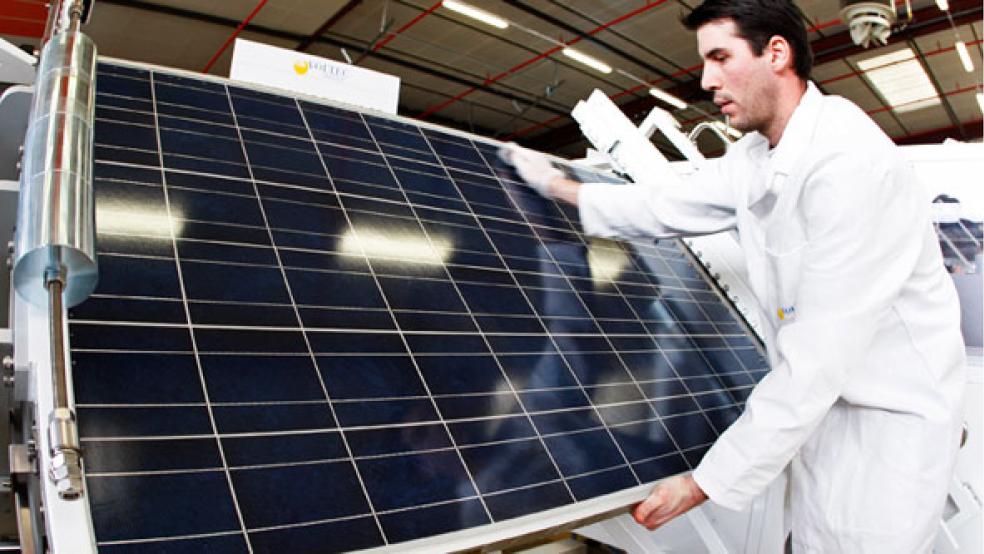President Obama might not get anywhere near the United Nations’ sustainable development conference in Rio de Janeiro next week: The bankruptcy of solar cell manufacturer Solyndra is almost certain to play a starring role in negative campaign ads this fall. But if it did show up, he’d have something to crow about to the 80 heads of state expected to attend.
Despite Republican opposition to the Obama administration’s renewable energy promotion agenda, electricity generated by wind, solar and geothermal sources grew 59 percent in the last three years and accounted for 2.7 percent of the U.S. total in 2011, the sixth highest share among industrialized nations, according to a new report from the Natural Resources Defense Council.
Only a handful of European countries did better, led by frontrunner Germany.
Despite a gloomy climate that gets about as much sun as southern Alaska, Europe’s largest and richest economy has invested heavily in solar power in recent years and now generates 10.7 percent of all its electricity from renewable sources. That is up from 7.2 percent in 2008 and less than 3 percent in 2002, the first year covered by the report.
The report did not include hydropower, which is a major contributor to renewable electricity production in the U.S. It has little capacity to expand.
Among developing countries, coal-dependent China is the leading manufacturer and installer of renewable energy, the report noted. It more than quadrupled its wind and solar output in the past four years and now gets 1.5 percent of its electricity from renewable sources. China, the world’s second largest economy, led the world by investing $50 billion in clean energy last year, followed by the U.S. with $45 billion invested in renewables.
A decade ago, only four countries in the G-20 generated more than 1 percent of their electricity from renewable sources. By last year, that had grown to 14 nations, largely because of the governments’ growing concern about fossil fuels’ impact on the globe’s climate.
“It’s all about industrial policy,” said Dan Kammen, a professor of public policy at the University of California at Berkeley. European countries have adopted so-called feed-in tariffs, where local renewable producers, including home-installed rooftop solar collectors, receive direct payments from utilities for the electricity they produce.
About three quarters of U.S. states have adopted percentage goals for utilities, known as renewable portfolio standards. But they have proven less effective at promoting solar and wind installations because there are only minor penalties attached. The size of the penalties determines what utilities are willing to pay for the surplus electricity generated by solar and wind installations during their peak production hours.
Meanwhile, China has embarked on a conscious policy aimed at dominating the global renewable energy production market. U.S.-based solar manufacturers last year successfully brought an anti-dumping case against Chinese firms. Solar installers, however, argued against the countervailing duties because they benefit by purchasing lower-cost, Chinese-made solar cells.
“Their twelfth five-year plan identifies a clear role for renewable energy, both in domestic production and in exports,” Kammen said. “The U.S., on the other hand, did not pass an energy bill,” and House Republicans do not support continued subsidies for domestic manufacturers.
In fact, the outlook for further expansion of renewable energy is cloudy everywhere but China. If Republicans win this fall’s election or simply maintain control of the House, they’ve promised to block any extension of direct government subsidies like the production tax credit or the loan guarantees that went to companies like Solyndra. In Europe, governments reeling from the ongoing banking and debt crisis are looking to cut back on their direct subsidies.
That should leave China with a wide open field to dominate what is likely to become a major 21st century industry. While global demand for renewable energy sources won’t reach the 15 percent target for 2020 established at the first Rio sustainable energy summit in 1992, it is expected to triple in size by then to meet more than 7 percent of total global electricity demand, the NRDC report said.
SUBSIDIES ON THE HOT SEAT
One of the major issues likely to come up at the summit is the continued high level of subsidies that flow to fossil fuel research, production and consumer subsidies, which the G-20 pledged to phase out at its 2009 summit. An International Energy Agency (IEA) report issued last fall estimated that global subsidies for fossil fuels rose 36 percent last year to $409 billion as oil prices soared. Aid to renewables rose just 10 percent to $66 billion.
The subsidies are “creating market distortions that encourage wasteful consumption,” the IEA said. “The costs of subsidies to fossil fuels generally outweigh the benefits.”
Fossil fuel producers in the U.S. bristle at the charge, especially when it comes to electricity. The coal industry, the single largest fuel source for U.S.-produced electricity, receives research subsidies and depletion allowances that are greater in value than the subsidies given to renewable energy sources.
“Fossil fuels receive more overall,” agreed Jason Hayes, a spokesman for the American Coal Council. “But if you do it on a kilowatt-hour basis, renewables receive 1,100 times more subsidies than fossil fuels.”


